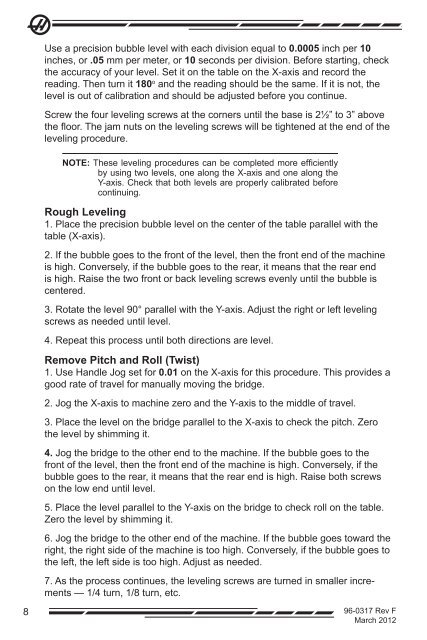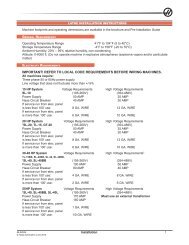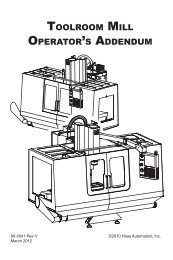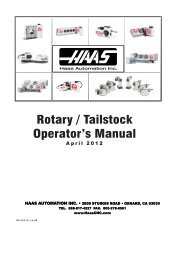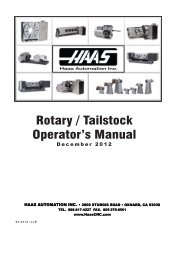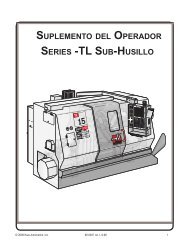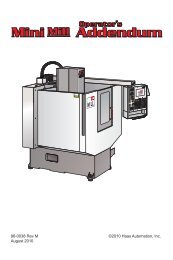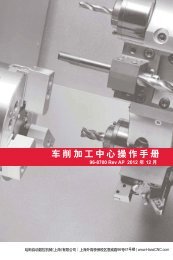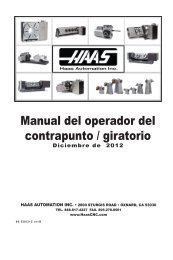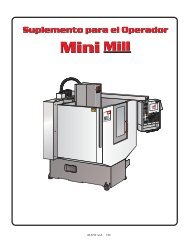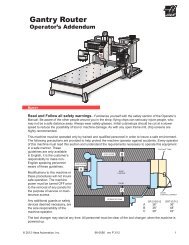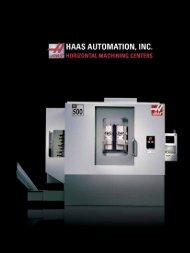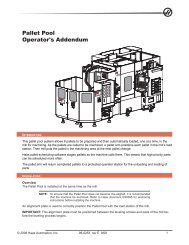Sheet Router (SR-100) - Haas Automation, Inc.
Sheet Router (SR-100) - Haas Automation, Inc.
Sheet Router (SR-100) - Haas Automation, Inc.
Create successful ePaper yourself
Turn your PDF publications into a flip-book with our unique Google optimized e-Paper software.
Use a precision bubble level with each division equal to 0.0005 inch per 10<br />
inches, or .05 mm per meter, or 10 seconds per division. Before starting, check<br />
the accuracy of your level. Set it on the table on the X-axis and record the<br />
reading. Then turn it 180 o and the reading should be the same. If it is not, the<br />
level is out of calibration and should be adjusted before you continue.<br />
Screw the four leveling screws at the corners until the base is 2½” to 3” above<br />
the floor. The jam nuts on the leveling screws will be tightened at the end of the<br />
leveling procedure.<br />
NOTE: These leveling procedures can be completed more efficiently<br />
by using two levels, one along the X-axis and one along the<br />
Y-axis. Check that both levels are properly calibrated before<br />
continuing.<br />
Rough Leveling<br />
1. Place the precision bubble level on the center of the table parallel with the<br />
table (X-axis).<br />
2. If the bubble goes to the front of the level, then the front end of the machine<br />
is high. Conversely, if the bubble goes to the rear, it means that the rear end<br />
is high. Raise the two front or back leveling screws evenly until the bubble is<br />
centered.<br />
3. Rotate the level 90° parallel with the Y-axis. Adjust the right or left leveling<br />
screws as needed until level.<br />
4. Repeat this process until both directions are level.<br />
Remove Pitch and Roll (Twist)<br />
1. Use Handle Jog set for 0.01 on the X-axis for this procedure. This provides a<br />
good rate of travel for manually moving the bridge.<br />
2. Jog the X-axis to machine zero and the Y-axis to the middle of travel.<br />
3. Place the level on the bridge parallel to the X-axis to check the pitch. Zero<br />
the level by shimming it.<br />
4. Jog the bridge to the other end to the machine. If the bubble goes to the<br />
front of the level, then the front end of the machine is high. Conversely, if the<br />
bubble goes to the rear, it means that the rear end is high. Raise both screws<br />
on the low end until level.<br />
5. Place the level parallel to the Y-axis on the bridge to check roll on the table.<br />
Zero the level by shimming it.<br />
6. Jog the bridge to the other end of the machine. If the bubble goes toward the<br />
right, the right side of the machine is too high. Conversely, if the bubble goes to<br />
the left, the left side is too high. Adjust as needed.<br />
7. As the process continues, the leveling screws are turned in smaller increments<br />
— 1/4 turn, 1/8 turn, etc.<br />
8 96-0317 Rev F<br />
March 2012


